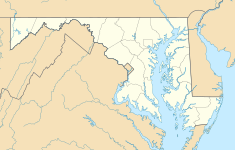Spurrier's Tavern
| Spurrier's Tavern | |
|---|---|
| Nearest city | Jessup, Maryland |
| Coordinates | 39°10′19.5″N 76°47′11.5″W / 39.172083°N 76.786528°WCoordinates: 39°10′19.5″N 76°47′11.5″W / 39.172083°N 76.786528°W |
| Built | 1771 |
| Demolished | 1835 (by fire) |
Spurrier's Tavern was a tavern and horse-changing depot which stood by the main road between Baltimore and Washington, D.C. (now U.S. Route 1) from 1771 to 1835 near what is now Jessup, Maryland.
The tavern was built on 190 acres of land patented by Thomas Spurrier as "Spurrier's Lot" which fronted the trail from Philadelphia to Georgetown. During the American Revolutionary War, Spurrier's tavern was significant as a supply and resting point for the Continental Army; George Washington was a frequent visitor, spending a night in the tavern en route to his inauguration. It became the central meeting place of the Elk Ridge Militia. In 1781 the depositions of the contested will of James MacGill of Athol were taken at the tavern. Thomas Twining, a British passenger on a stage coach trip from Baltimore to Georgetown in April 1796, described Spurrier's as a "solitary inn" at which they "found the usual substantial American breakfast".
John Spurrier's estate was sold in June 1811 to Rosalie Calvert (1778–1821). After 1812, the Inn was renamed Waterloo by an anti-Napoleon innkeeper; the tavern served stagecoaches bound for Washington, D.C., during the early 19th century. On December 7, 1812, the state authorized a company to run the Baltimore-Washington road in front of Spurrier's as a turnpike. John Pendleton Kennedy, a young militiaman during the War of 1812, wrote of his Fifth Regiment's stopping in 1814 "at Waterloo, then McCoy's Tavern" for dinner, ultimately on their way to Bladensburg. In 1815, brick stables were built following a hurricane. An 1827 lithograph by T.M. Baynes shows the inn as a tall two-story 3-bay wide structure with front porch, lantern, and sign servicing stagecoaches. The Inn had individual rooms and hot baths for travelers. Following nearly twenty years without a title, the property was recorded in 1832 to the widowed husband of Rosalie, George Calvert (1768–1838) of Anne Arundel County (Liber W.S.G 17 folio 193-195). At its peak before rail traffic in 1835, the Phoenix Stage serviced passengers between Baltimore and Washington with five-hour trips, with the tavern as midpoint. The tavern burned down on July 3, 1835, at a time when Irish and German B&O work teams were fighting and burning each other's camps nearby. The furniture was saved by stage passengers at the inn.
...
Wikipedia

